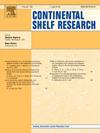智利南部连接外海与智利内海的瓜福口潮下输送动力学
IF 2.2
3区 地球科学
Q2 OCEANOGRAPHY
引用次数: 0
摘要
智利内海(CIS)和智利南部的峡湾地区是鲑鱼养殖等人类活动的场所。在南方丰产的夏季,CIS通过瓜福口(一个非常浅的海峡)与南太平洋交换热量、盐、溶解氧和营养物质。潮汐影响CIS的生产力,这是环流模式在估计交换通量时通常不考虑的高频强迫。在这项工作中,利用潮汐强迫的高分辨率区域模式评估了瓜佛口的流入、流出、净、质量和营养通量。将模型输出(温度、盐度和水流)与水动力数据进行比较。潮汐强迫对夏季平均海流和输送的影响是量化的。这些发现与低分辨率、常用的一般环流模型的结果进行了比较。拉格朗日模拟方法强调了从公海经瓜佛口的水团主要来自瓜佛口以南地区。本文章由计算机程序翻译,如有差异,请以英文原文为准。
Dynamics of the subtidal transport through the Guafo Mouth connecting the open ocean and the Chilean Inland Sea in southern Chile
The Chilean Inland Sea (CIS) and the fjords region in Southern Chile host human activities such as salmon aquaculture. During the productive austral summer, the CIS exchanges heat, salt, dissolved oxygen, and nutrients with the Southern Pacific Ocean via the Guafo Mouth, a very shallow strait. Tides influence the productivity of the CIS, a high-frequency forcing typically not considered in circulation models when estimating exchange fluxes. In this work, the inflow, outflow, net, mass, and nutrient fluxes through the Guafo Mouth are evaluated using a high-resolution regional model forced by tides. Model output (temperature, salinity, and currents) is compared to hydrodynamic data. The impact of tidal forcing on summer-mean currents and transports is quantified. These findings are compared with results from a lower-resolution, commonly used, general circulation model. A Lagrangian modeling approach highlights that the water masses transiting from the open ocean through the Guafo Mouth mainly originate from the region south of the mouth.
求助全文
通过发布文献求助,成功后即可免费获取论文全文。
去求助
来源期刊

Continental Shelf Research
地学-海洋学
CiteScore
4.30
自引率
4.30%
发文量
136
审稿时长
6.1 months
期刊介绍:
Continental Shelf Research publishes articles dealing with the biological, chemical, geological and physical oceanography of the shallow marine environment, from coastal and estuarine waters out to the shelf break. The continental shelf is a critical environment within the land-ocean continuum, and many processes, functions and problems in the continental shelf are driven by terrestrial inputs transported through the rivers and estuaries to the coastal and continental shelf areas. Manuscripts that deal with these topics must make a clear link to the continental shelf. Examples of research areas include:
Physical sedimentology and geomorphology
Geochemistry of the coastal ocean (inorganic and organic)
Marine environment and anthropogenic effects
Interaction of physical dynamics with natural and manmade shoreline features
Benthic, phytoplankton and zooplankton ecology
Coastal water and sediment quality, and ecosystem health
Benthic-pelagic coupling (physical and biogeochemical)
Interactions between physical dynamics (waves, currents, mixing, etc.) and biogeochemical cycles
Estuarine, coastal and shelf sea modelling and process studies.
 求助内容:
求助内容: 应助结果提醒方式:
应助结果提醒方式:


